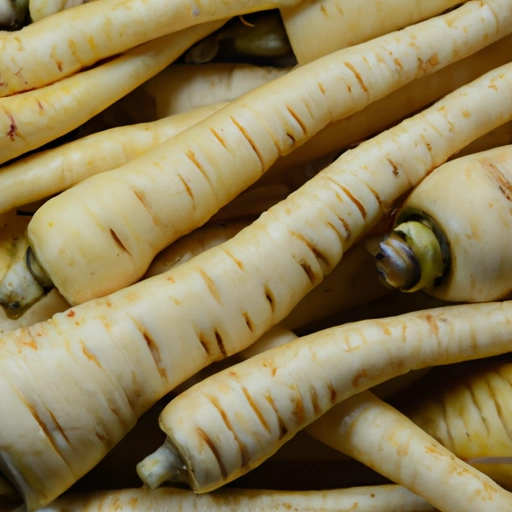Parsnip
Description

The parsnip is a root vegetable closely related to the carrot and parsley. It has a creamy white color and a sweet, nutty flavor that intensifies with cooking. Parsnips are typically harvested in late fall after the first frost, which is when they become sweeter. They can be used similarly to carrots in recipes and are rich in nutrients and fiber.
Common uses
Parsnips are commonly used in soups, stews, and as roasted side dishes. They are also pureed for a creamy texture in sauces and soups or mashed as a healthier alternative to mashed potatoes. Parsnips can be eaten raw but are more often cooked, which brings out their natural sweetness.
Nutritional value
Calories
A medium parsnip (about 9 inches long or 170 grams) contains approximately 100 kcal (418 kJ).
Protein
Parsnips provide about 1.5 grams of protein per medium-sized vegetable.
Fat
This root vegetable is low in fat, containing less than 0.5 grams per serving.
Carbohydrates
Parsnips are rich in carbohydrates, with a medium-sized one offering around 24 grams.
Vitamins
They are a good source of several vitamins, including folate (vitamin B9), vitamin C, and vitamin E.
Minerals
Parsnips also contain essential minerals such as potassium, magnesium, and manganese.
Health benefits
Parsnips are high in dietary fiber, which aids digestion and helps maintain a healthy weight. The presence of antioxidants like vitamin C and E contributes to immune system support and skin health. Additionally, the folate in parsnips is important for cell growth and replication, making them beneficial for overall wellness.
Potential risks
While parsnips are generally considered safe for consumption, they do contain furanocoumarins, which can cause skin reactions in sensitive individuals when handling parsnips and then exposing the skin to sunlight. It's also essential to avoid consuming wild parsnips, as they can be confused with the poisonous water hemlock.
Common recipes
Parsnips are found in classic recipes like roasted root vegetables, creamy parsnip soup, and hearty pot roasts. They also make an appearance in cakes and bread where they add moisture and flavor.
Cooking methods
Popular cooking methods for parsnips include roasting, boiling, steaming, and sautéing. They can also be baked or fried to make chips or fries.
Pairing with other ingredients
Parsnips pair well with flavors like apple, nutmeg, and ginger. They complement meats such as pork, chicken, and beef, and can also be combined with other root vegetables like carrots, turnips, and potatoes.
Summary
Parsnip is a versatile and nutritious root vegetable with a sweet, earthy flavor. It has a rich history and a variety of uses in cuisines around the world. Whether roasted, mashed, or pureed, parsnips add a unique touch to any dish and offer numerous health benefits. However, care should be taken in their handling to prevent potential skin reactions.